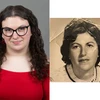Burchfield Penney launches year-long observance of 100th anniversary of the first water regulations with new exhibition that aims to help educate and cure the ills that plague Scajaquada Creek.
A new installation will explore a beautiful stream once home to fish and wildlife that turned into a sewer. The artist hopes of nursing it back to health. Using Scajaquada Creek as his inspiration, Alberto Rey, artist, fly fishing guide and educator, will aim to reconnect with this important piece of the local environment through traditional and contemporary art media.
Biological Regionalism: Alberto Rey, on view Friday, February 14–Sunday, May 18, 2014 in the Center’s East Gallery, is the first in a series of installations and activities in 2014 that will mark the 100th anniversary of first water regulations in the United States. The first numerical drinking water regulations were adopted October 21, 1914.
In conjunction with the exhibition SUNY Press has published a book on my work that outlines the progression of my art and how it has been affected by my life, fly fishing, social investigations and environmental issues.
Nearly 100,000 people live within the Scajaquada Creek watershed in five communities, including Buffalo, Cheektowaga, Lancaster, Village of Lancaster and Depew. A mix of urban and residential development, the waterway originates in Lancaster and flows through— or tunnels under─ these five municipalities before emptying into the Niagara River. “Scajaquada Creek has been used, abused and celebrated throughout this community’s history,” says Scott Propeack, associate director, chief curator. “Alberto Rey’s paintings document idyllic scenery around the creek pairing it with water samples that show the stream is far from clean and perfect. It’s his way of tracking the environment while using his work to create a bold statement on ecology. His paintings and ecological research—water samples, video and artifacts—are showcased.”
An avid fisherman married to the waterways, Rey’s films and videos have been collected by museums, presented internationally and screened nationally and his illustrated articles and artwork have graced the covers and pages of Gray’s Sporting Journal, Art of Angling Journal, Fish and Fly Magazine, American Angler, Saltwater Fisherman and Buffalo Spree.
“We spend most of our lives driving from one enclosed space to another. We often drive next to streams or bodies of water without knowledge about their condition, use or history. Our connection with the natural landscape is limited by own our exposure and information about it. ” says Rey. “Scajaquada Creek is a perfect example of a neglected stream that’s changed dramatically over the past decades. It's was so badly polluted at one time that a three-mile stretch of tunnel was made for it and buried under the city of Buffalo where it remains to this day.”
A strong supporter of the Burchfield Penney since graduate school at the University at Buffalo, Rey says when given the opportunity to exhibit, he wanted to present something ambitious for the Center. “I wanted to create a site-specific installation that would be larger in scale than any past projects. This project that would encapsulate 2-3 years of research, documentation, and studio work,” describes Rey. “Biological Regionalism is a compilation of new work made for the Burchfield Penney, the Buffalo area and the stream that runs by the gallery.”
Although much of the industry that lined Scajaquada Creek shores now is gone, it left its mark in the stream's contaminated sediments. “The only way to make a difference in this body of water is to know more about it; if we’re not connected to stream in some way, it is very easy to dismiss,” adds Rey who also praised Buffalo Niagara Riverkeeper, a community-based clean water advocate, for their assistance and support of the exhibition. “A lot of community groups are interested in cleaning up Scajaquada Creek, but too often other issues move to the forefront. Biological Regionalism is an opportunity to bring the issue up again and continue the conversation. In this exhibition, I try to use aesthetics as a way to seduce the viewer into connecting with the artwork and to its content. If it’s successful, the audience leaves with a new interpretation of the environment.”
The exhibition includes a series of large paintings, water samples and related data, historical information, ecological research, large maps, video projections, process work samples, related programming and presentations and selection of Alberto's past works. “The objective of the exhibition is to bring the language of both art and science to bear upon a complex of cultural, social, economic, technological and geopolitical issues,” said Anthony Bannon, Ph.D., executive director of the Burchfield Penney and research professor at SUNY Buffalo State.
About Alberto Rey
Over the past 25 years, Rey's artwork has been influenced by his Cuban lineage and his attempt to find a sense of identity in a complex contemporary environment. His abstract work from 1982-92 dealt with issues related to layered memories of Cuban iconography and his American experiences. After 1992, his drawings and paintings incorporated realistic imagery as an attempt to make clear connections between his past concerns and art history, regionalism, and Cuban-American politics.
In 2000, his reflections on contemporary society started to incorporate environmental issues and its relationship to art history, biology and social disconnections with nature. Shortly afterwards, he also began to work in film and video. Rey's paintings can be found in more than 20 museum collections and have been in more than 130 exhibitions and his films/videos have been screened internationally.
Born in Havana, Cuba, in 1960, Rey received his political asylum through Mexico in 1963 and moved to Miami, Fla., in 1965. He received his B.F.A from Indiana University of Pennsylvania and an M.F.A. in painting from UB in 1987. He is currently SUNY Distinguished Professor of Visual Arts and New Media at SUNY Fredonia.
About the Burchfield Penney Art Center at SUNY Buffalo State
Founded in 1966 on the campus of SUNY Buffalo State, the Burchfield Penney Art Center is dedicated to the art and vision of renowned American watercolorist Charles E. Burchfield (1893–1967) and the distinguished artists of Western New York state. In 2008, the Burchfield Penney expanded from its location in Rockwell Hall to a new $36 million freestanding facility in the heart of Buffalo’s Museum District. Designed by Gwathmey Siegel and Associates Architects, the museum includes more than 84,000 square feet dedicated primarily to galleries, as well as education and program space. It is home to the world’s largest collection of artwork and ephemera by Burchfield and a collection of more than 8,000 works by over 850 artists. The Burchfield Penney was the first LEED certified art museum in New York State and was featured by travel editors of the New York Times as one of the “44 Places to Go in 2009.” For more information go to, www.burchfieldpenney.org



